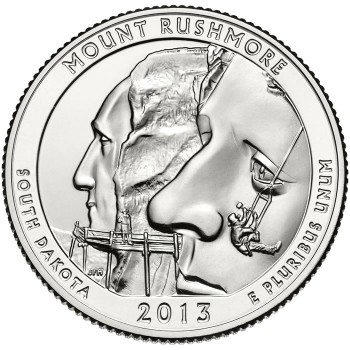The final quarter-dollar from the United States Mint for 2013 is the Mount Rushmore National Memorial Quarter honoring the site located in South Dakota. The release also marks the twentieth in the United States Mint America the Beautiful Quarters® Program. It is scheduled to enter circulation on November 4, 2013.
Also on November 4, 2013, rolls, sets and bags of the coins will be made available by the US Mint at www.usmint.gov/catalog. These Mount Rushmore quarters are produced in circulating-quality and from the US Mint facilities in Denver, Philadelphia and San Francisco.
Strikes from Denver and Philadelphia will eventually make their way into circulation, though it can take a very long time since banks and other financial institutions cannot order coins by a specific design or from a specific United States Mint facility. (Read about where to get quarters.) Quarters from San Francisco will not enter circulation as they are struck specifically for coin collectors. The US Mint also produces uncirculated and proof quarters for coin collectors, with most of them already released and also available at www.usmint.gov/catalog.
Several designs were proposed for the reverse or tails side of the Mount Rushmore National Memorial Quarter. These were evaluated by the Citizen’s Coinage Advisory Committee (CCAC) and the U.S. Commission of Fine Arts (CFA). These two entities made their recommendations and from there, the United States Mint recommended designs to the Treasury Secretary who, by law, is responsible for selecting final designs for all America the Beautiful Quarters®. (Read and look at line art images of all five 2013 quarter designs.)
Shown on the reverse of the Mount Rushmore National Memorial quarter is a design inspired by photos of men who added the final details to Thomas Jefferson’s face, one of the four Presidents sculpted on the monument. This perspective offers a unique educational aspect compared to past coins that have also depicted the national memorial. Inscriptions around the design are MOUNT RUSHMORE, SOUTH DAKOTA, 2013 and E PLURIBUS UNUM. The reverse was both designed and sculpted by Joseph Menna.
Like past quarter-dollars and all those in the America the Beautiful Quarters series, whether they feature national parks or national sites, found on the obverse or heads side is John Flanagan’s portrait of George Washington. Surrounding inscriptions read UNITED STATES OF AMERICA, IN GOD WE TRUST, LIBERTY and QUARTER DOLLAR.
Along with these quarter dollars, the United States Mint will offer five ounce silver coins containing the same designs as the quarters but in a much larger frame work since each is 3 inches in diameter. The bullion, 99.9% pure silver coins were authorized by the same Act permitting the America the Beautiful Quarters, but the Mint also strikes uncirculated five ounce silver coins for collectors based on the authority given the Treasury Secretary to design.
Four other quarter-dollars launched in 2013 prior to the Mount Rushmore National Memorial Quarter. These include the White Mountain National Forest Quarter, the Perry’s Victory and International Peace Memorial Quarter, the Great Basin National Park Quarter, and the Fort McHenry National Monument and Historic Shrine Quarter. (Read about the 2013 quarters.)
Mount Rushmore National Memorial information
Mount Rushmore National Memorial of South Dakota was worked on for 14 years by nearly 400 workers who carved the faces of four of America’s most famous presidents. Sculptor Gutzon Borglum was in charge of the operation for all but one year. Due to his death, his son supervised the final year of the nearly $1 million dollar project.
George Washington, Thomas Jefferson, Theodore Roosevelt and Abraham Lincoln are the faces that adorn the monument. Borglum felt that each of these presidents played an important role in expanding the United States of America.
A goal of Mount Rushmore was to bring tourism to South Dakota. With an estimated 2 million visitors a year, that goal is continually met.
Mount Rushmore, the mountain on which the carving is named after, was named itself after Charles E. Rushmore, an attorney in New York City that visited the Black Hills in 1885.

